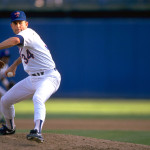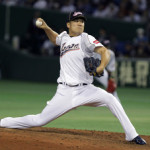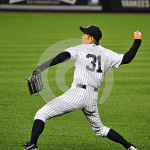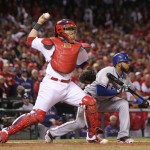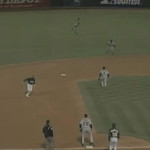Throwing a Baseball
Nothing happens in a baseball game until after the first pitch is thrown. Throwing a baseball, then, seems to be a very important part of the game. In fact, Pitchers (and Power-Hitters) are considered the most prominent characters in the game. The ability to throw the ball hard and far evokes a mythical aggrandizement from which legends are made. What is it that enables one individual to throw harder and farther than another? Are some people blessed with natural ability to throw better than others? It’s hard to say when and how an individual developed certain physical characteristics associated with strength, or whether he acquired some unusual pre-natal condition that facilitated an accentuated leverage point, to produce a greater aptitude for throwing! But two things are certain: it has been observed countless times, that the seemingly “gifted” athlete cannot reach his/her full potential unless the proper body-mechanics are employed; and the “not-so-gifted” sometimes attains a higher level of success with intellectual astuteness and the utilization of proper body-mechanics.
It is common to evaluate a player’s throwing ability by saying, “. . . he/she has a strong or weak arm.” It is incorrect, though, to assume that the power of the throw is determined by the strength of the arm. The main power source for throwing is the “Body.”
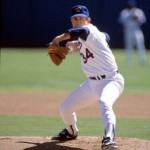
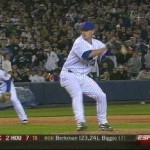

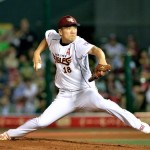
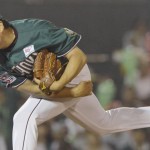 The arm provides only a fraction of the power. From the coordinated precision of the movement from the feet to legs, to hips, to torso, to shoulders, to arm(s), wrist, hand,
The arm provides only a fraction of the power. From the coordinated precision of the movement from the feet to legs, to hips, to torso, to shoulders, to arm(s), wrist, hand, 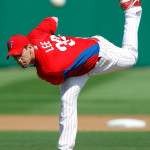
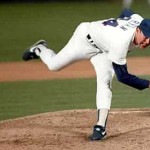
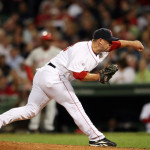 and fingers is the ultimate power registered in the “perfect throw.” Obviously, the player with the stronger body and arm, who applies the mechanics perfectly, will be more effective than the weaker player.
and fingers is the ultimate power registered in the “perfect throw.” Obviously, the player with the stronger body and arm, who applies the mechanics perfectly, will be more effective than the weaker player.
The stronger the body the greater the possibility for a strong throw, as long as the application of the proper mechanics for movement of shoulder(s) and arm come into play. Unfortunately, the stronger the body the greater is the vulnerability to injury of the shoulder and elbow if the application of proper mechanics is not enforced. If the power generated by the body is complete, the torque action of the twisting hips and torso could be too great for a shoulder and arm ill-prepared to deliver the final dimension of the throw. If the shoulder is not locked into a position of stability, to launch the (bent) arm and that (5-ounce) ball forward at the precise time, the strain of having transported the spherical object from the point of origin to destination could have a deleterious effect on the accompanying extremities.
The weight of a 5-ounce object doesn’t seem like it should have any major affect on the throwing apparatus of a strong, well-conditioned athlete. But if you think about the strain one feels in his shoulders, while merely extending the arms outwardly, away from the body, and sustaining that position for a period of time, you could see how any additional weight would accentuate the strain. Even more stress would be added if you realize the extra force exerted on “those joints” by the weight of the moving arm and ball. “The farther the ball moves away from the body, as the arm is preparing to throw it, the heavier the weight will be to the strain of the shoulder (and elbow).”
As the ball is being prepared for its launch from the thrower’s hand it should remain as close as possible to the “Body-Proper,” while a bent arm is “whipping” itself into the forward thrusting position. (Nolan Ryan was the best exponent of this “principle” as a pitcher, as was Darren Dreifort one of the best examples of poor proficiency.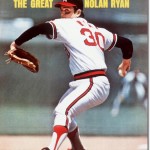
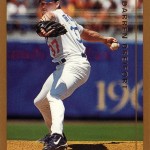
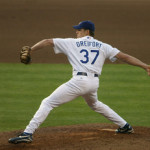
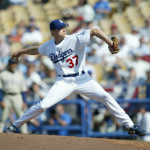 Now Masahiro Tanaka is the best example of perfect pitching mechanics.
Now Masahiro Tanaka is the best example of perfect pitching mechanics. 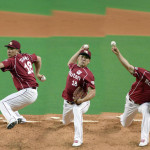


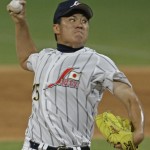 Ichiro Suzuki is the best example as an outfielder. Raphael Furcal, Derek Jeter, and Robinson Cano as infielders! And Yadier Molina, from the catching position!)
Ichiro Suzuki is the best example as an outfielder. Raphael Furcal, Derek Jeter, and Robinson Cano as infielders! And Yadier Molina, from the catching position!)
The coordinated action of the entire body (right and left sides) provides the power for the correct arm movements to occur rapidly (and safely), and thus sustain a whip-like action to move through the “throw” like a wave of tremendous force.
Is throwing a baseball composed of a generic component to which all prospective players could and should strictly adhere in order to properly promote the development of the correct mechanics? The most productive “throwers” of the ball, from each outfield and infield position are they whose technique is almost identical in their respective positions (at least in the “Big-Leagues”). When an infielder is making his toughest play (one that entails his longest possible throw), he will instinctively position his body and administer his arm action in a manner similar to all Big-leaguers under similar circumstances. The most conclusive example of perfect proficiency in throwing from the outfield is that illustrated by Ichiro Suzuki in his “rookie-season” as the Mariners were playing the Oakland “A”s. On a base hit to Right Field, a speedy runner from first was racing his way to what he thought was going to be an “easy safe at third.” Instead, because of the magnificent display of body-control and mechanical throwing efficiency, Ichiro “gunned-down” the exasperated runner with a perfectly straight, accurate, and powerful throw—the recounting of which has been displayed on T.V. Sports Stations and Videos ever since.
Speed of “range,” competency to receive, quickness to release, strength to deliver, and accuracy to direct the ball (to the intended base) are integral in determining the optimum effectiveness of the fielder – the latter three relative to the precise dynamics of throwing mechanics. For a short-stop to make “that” throw from “deep-in-the-hole,” or an outfielder from right-field to third base, absolute, correct technique is mandatory. IF he doesn’t come up “throwing over the top,” but rather side-armed, the ball will likely not be 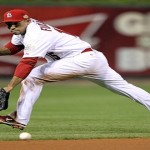
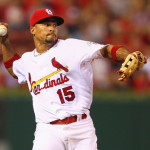
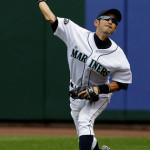 there on time (unless for an extremely slow runner). The “closest distance between two points is a straight line.” Therefore, “over-the-top” will facilitate a straight line, while “side-armed” will produce a horizontal/vertical arc that will likely allow the runner to be safe! From a close distance, a short arc is acceptable only if the infielder has no other recourse when he’s charging a slow hit ball, but to throw immediately from below as his hand touches the ball.
there on time (unless for an extremely slow runner). The “closest distance between two points is a straight line.” Therefore, “over-the-top” will facilitate a straight line, while “side-armed” will produce a horizontal/vertical arc that will likely allow the runner to be safe! From a close distance, a short arc is acceptable only if the infielder has no other recourse when he’s charging a slow hit ball, but to throw immediately from below as his hand touches the ball.
In Baseball, “Size” is not the determining factor for the success of an individual, whether for throwing or hitting a baseball. It is not a freak accident that Pitchers like 5 foot 8 and 9 inch Billy Wagner and Craig Kimbrel throw the ball as hard as 6 foot 3 inch and 6 foot 10inch Nolan Ryan and Randy Johnson !

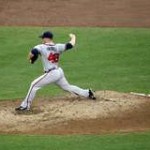

 (And 5 foot 8 inch Joe Morgan and Jimmy Wynn could hit balls as far as guys almost twice their size.) Size does not determine strength, but “correct mechanics” and reinforced thought and muscular integration with the synergistic movement of body-parts does produce the most energy for rapid motion as it is converted to power. (A similar analogy would be that of a Karate master applying the “focus” to his punch or strike.)
(And 5 foot 8 inch Joe Morgan and Jimmy Wynn could hit balls as far as guys almost twice their size.) Size does not determine strength, but “correct mechanics” and reinforced thought and muscular integration with the synergistic movement of body-parts does produce the most energy for rapid motion as it is converted to power. (A similar analogy would be that of a Karate master applying the “focus” to his punch or strike.)
Aside from the apparent size differential, the four pitchers mentioned above have one thing in common: When they begin their power thrust with the turning upper body (including the shoulder and arm) after the bent legs have initiated the power drive of the twisting hips, the throwing arm has already been locked into place at a position of at least 90 degrees in order to assure the fastest possible forward rotation of the shoulder to allow a quick moving arm to assist the wrist, hand, and fingers to propel the ball at maximum speed. Therefore, the principle throwing criterion mentioned earlier comes into play, namely: “The farther the ball moves away from the body, as the arm is preparing to throw it, the heavier the weight will be to the strain of the shoulder (and elbow).” As the ball is being prepared for its launch from the thrower’s hand it should remain as close as possible to the “Body-Proper,” while the bent arm is “whipping” itself into the forward thrusting position. It is only reasonable to presume that a bent arm throughout the entire action prior to the throw would be the most efficient means of facilitating a rapid, powerful, and “safe” shoulder thrust, since there would be less weight to transport to the “launch.”
It is widely accepted, from the “Big-Leagues” to “Sandlots,” that on the Infield, the Third Base-men and Short-stops have to have the stronger arms because of the longer distance they most often throw the ball. Second Base-men and First Base-men don’t usually have to make as long a throw. But, obviously, it is to a Team’s best interest to have good – arms at all infield positions because of the few (and sometimes critical) times when a strong throw could mean the difference in a safe or out, win or loss.
In the Outfield, the Center-fielder and Right-fielder usually have more long throws than the Left-fielder, but the best possible outfield would be comprised of equal arm-strength for the same obvious reasons as well as to be able to inter-change positions at any time.
All mental facility and “character” being equal, the “Unified Field Theory-Experience” as applied to Baseball-Throwing would essentially mean that all players in all 9 defensive positions would have the “same” ultimate power and accuracy in their throws no matter what their respective sizes are, based primarily on equal understanding and application of the principle of the “infallibly scientific art” of correct throwing mechanics. This phenomenon, if feasible, would be a comforting delight for any manager or team, for the prospect of interchangeable parts could be practically beneficial.
However, the arena in which more differentiation of skill is noticeable is in the “designation” of “Fielding.” If all the players on a team could throw equally well, that condition may not necessarily transfer over to the “Art of Fielding,” either in the infield or the outfield. There have been infielders who began their Big-Leagues careers playing Short-stop (like Robin Yount), then moved to Center-field. And Center-fielders (like Bill Russell) who moved to Short-stop! Catchers (like Troy Percival and Jason Mott) who became Pitchers, while a catcher (like Craig Biggio) became an All-Star Outfielder and Second Base-man. Correct throwing mechanics (as well as batting skills in some cases) kept them “in the game” until they found the position best suited for them. Now, is there a “generic” component that would foster the development of all prospective team players to be equally adept in “fielding” all positions with the “same” proficiency?
Next: The “Art” of Fielding a Baseball

